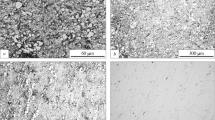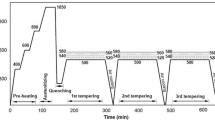Conclusions
Steel D7KhFNSh is suitable for manufacturing parts operating under conditions of compression. The best combination of mechanical properties in compression is obtained by oil quenching from 840° and tempering at 170–200°.
Similar content being viewed by others
Literature cited
V. N. Vinogradov, G. M. Sorokin, and G. K. Shreiber, Impact-Abrasive Wear of Milling Cutters [in Russian], Nedra, Moscow (1975), p. 168.
Ya. B. Fridman, Mechanical Properties of Metals [in Russian], Vol. 2, Mashinostroenie, Moscow (1974), p. 368.
G. M. Sorokin and S. N. Bobrov, "Effect of tempering temperature on the fatigue strength of high-strength tool steel," Metalloved. Term. Obrab. Met., No. 9, 30 (1974).
S. N. Bobrov and L. N. Turov, "Wear and failure of the teeth of milling cutters made from uncarburized steel," Mashiny i Neftyanoe Oborudovanie, No. 5, 14 (1973).
Additional information
I. M. Gubkin Moscow Institute of the Petrochemical and Gas Industry. Translated from Metallovedenie i Termicheskaya Obrabotka Metallov, No. 6, pp. 48–49, June, 1978.
Rights and permissions
About this article
Cite this article
Bobrov, S.N. Effect of tempering temperature on the mechanical properties of high-strength tool steel. Met Sci Heat Treat 20, 479–480 (1978). https://doi.org/10.1007/BF00773993
Issue Date:
DOI: https://doi.org/10.1007/BF00773993




